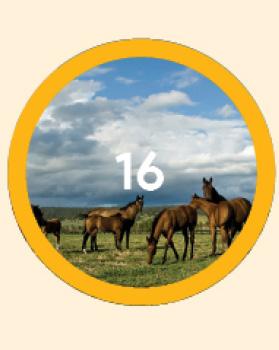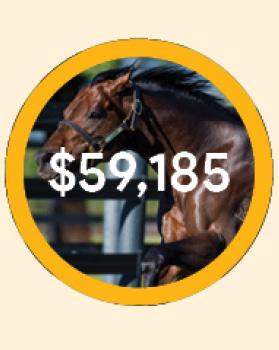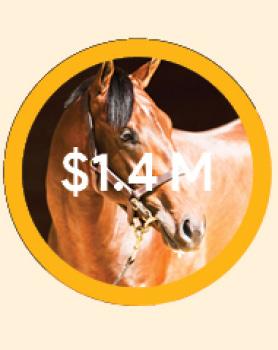
6 minute read
No Horsing Around When It Comes To Stallion Fertility | AgriFutures
NO HORSING AROUND WHEN IT COMES TO STALLION FERTILITY Thanks to the ground breaking work of University of Newcastle postdoctoral researcher Dr Zamira Gibb, a team of researchers and funding from AgriFutures™ Thoroughbred Horses Program, the development of a small device that can predict stallion sperm quality at the time of breeding.
Dr Gibb works with the thoroughbred horse industry including the Hunter Valley Equine Research Centre and equine reproductive specialists, using natural methods to improve fertility and improve reproductive outcomes, with a focus on stallions. “Thoroughbred horses are selected for breeding on the basis of pedigree and athletic performance as opposed to reproductive traits and therefore, like humans, are not subjected to selection pressure for fertility,” said Dr Gibb. “This has resulted in equine and human populations with significantly lower per cycle conception rates than other species.” Dr Gibb and her team at the University of Newcastle have been trialling a device which allows a test to be performed on-farm which is a greater predictor of the success of a cover than conventional methods. This is how it works. At the time of cover, the stallion handler captures a drop of semen which is known in scientific terms as the “post coital urethral sample”, or on-farm as a ‘dismount sample’, in a warm cup. Dr Gibb and her team have developed a device into which this droplet is placed to assess the sperm’s characteristics to show the likelihood of pregnancy. “Previously, the shape or motility of the sperm cells were used as a predictor of fertility, but we have shown that the defining important factor is sperm metabolic activity in a dismount semen sample which helps identify breedings, or covers, which are unlikely to produce a pregnancy,” said Dr Gibb “This is really important because it allows managers to schedule the mare to be rebred on the same cycle to increase the chance of a positive pregnancy outcome. By increasing per cycle conception rates, mares will conceive earlier in the breeding season, resulting in earlier foals which will attract higher prices at yearling sales and be more competitive in age-related races.” Dr Gibb’s work has also been influenced by Laureate Professor John Aitken, the Director of the University of Newcastle’s Priority Research Centre for Reproductive Science, who asked her to head up a new team in horse fertility while she was in her last year of her PhD.
“Professor Aitken is one of the world’s leaders in human sperm research and although not translating directly due to differences in metabolic processes between horse and human sperm, working alongside a world leader in human fertility has been a great advantage for the horse fertility team,” said Dr Gibb. “We are gaining invaluable insights into the basic biology of stallion sperm metabolism and this information is key in guiding our research and delivering key findings for the industry both here and internationally.” Research shows external factors such as environmental fluctuations and changes to management practices also play a part in falling fertility rates. Dr Gibb said the research team has also looked holistically at improving horse health by considering external changes such as reducing temperature levels for both stallions and mares. “Like us, horses get stressed with extended periods of intense heat so something as simple as installing misters at the hottest part of the day, can improve fertility,” said Dr Gibb. AgriFutures Australia Program Manager Research, Annelies McGaw said one of the overall aims of the Thoroughbred Horses Program is to assist the thoroughbred horse industry by developing collaborative strategies to improve breeding outcomes in a safe and sustainable way. “We hope the device will become an invaluable tool for use in research and will be as well used as a microscope or flow cytometer, a device which measures the characteristics of cells,” said Ms McGaw. The next step is the development of a device which can be used by general farm staff. “We are now ready to construct prototype devices and disseminate them to partner farms for testing,” said Dr Gibb.
Advisory Panel Members - Prof. Nigel Perkins (Chair) - Dr Catherine Chicken (Deputy Chair) - Derek Field - Jacqueline Stewart - Dr Craig Suann - Tas Reilley - Annelies McGaw (AgriFutures Australia Manager, Research)
AgriFutures Australia is committed to working with industry to deliver the research and development outcomes that meet rural Australia’s needs. We work closely with Advisory Panels to decide on research priorities and to make investment decisions each year.
Members of AgriFutures Australia’s Advisory Panels are selected following an open call process which involves a competitive skills-based assessment and/ or consultation with key industry bodies and stakeholders. The successful applicants are appointed to the respective Advisory Panel by the Managing Director of AgriFutures Australia. Applicants are required to declare any actual or perceived conflict of interest to the AgriFutures Australia Managing Director prior to appointment. Any subsequent conflicts of interest are managed in accordance with the Corporation’s Conflict of Interest Policy.
AgriFutures Australia is dedicated to embracing and promoting cultural, age and gender diversity on all of our Advisory Panels.To learn more about the AgriFutures Australia Advisory Panels and the members of the Thoroughbred Horses Program Advisory Panel please visit agrifutures.com.au/advisory-panels

Project spotlight:
A novel device for the on-farm assessment of stallion sperm fertility
Project ID: PRJ-011712 Principal investigator: Zamira Gibb Research organisation: The University of Newcastle
This project aims to help the thoroughbred horse industry by developing ways to improve reproductive performance by investigating stallion fertility.
Post-breeding ‘dismount’ semen samples from thoroughbred stallions are routinely collected throughout the season to do basic semen assessments. While conventional sperm assays, such as sperm concentration, motility and morphological assessments are a valuable first way of identifying sub-fertile stallions, they provide only moderate information on the functional competence of sperm cells.
The major objective of this project is to develop, test and validate a device which can measure the metabolic rate of sperm in a dismount semen sample, to identify samples which are unlikely to produce a pregnancy. This will allow stallion managers to schedule the mare to be re-bred on the same cycle if needed, to increase the chance of a positive pregnancy outcome. By increasing per-cycle conception rates, mares will conceive earlier in the breeding season, resulting in earlier foals which will attract higher prices at yearling sales and be more competitive in age-related races. The findings from this study will be pivotal in guiding both device modifications; and stallion and mare management strategies.
Project spotlight:
Rapid diagnosis of infectious agents of equine reproductive loss
Project ID: PRJ-011628 Principal investigator: Cheryl Jenkins wResearch organisation: NSW Department of Primary Industries
Equine reproductive loss due to infectious agents impacts significantly on Australian thoroughbred breeders. A range of bacterial agents and one particular viral agent are involved. Some of these also pose a significant occupational health risk to workers in this industry.
Accurate detection of the infectious agents is important for the management of affected mares. While nucleic acid testing is considered the ‘gold standard’, testing is normally only performed by well equipped veterinary diagnostic laboratories with molecular capabilities. This restriction means significant delays before diagnostic results are available.
This project will develop and evaluate rapid nucleic acid tests for two important causes of equine reproductive loss in Australia, Equine Herpes Virus1 (EHV1), a recognised cause of equine abortion, and Chlamydia psittaci, an emerging cause of reproductive loss as well as zoonotic disease of veterinarians and stud workers.
Current projects


Current projects

AgriFutures Australia key dates EvokeAG. : 18-19 February 2020
RD&E investment July - September 2019












